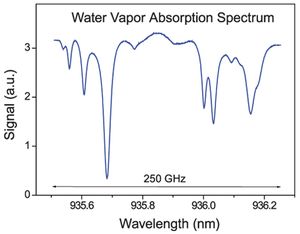Lasers for Spectroscopy
Ideal tools for laser spectroscopy

- Molecular and atomic spectroscopy
- Gas monitoring
- Trace gas analysis
Direct tunable laser absorption spectroscopy (TDLAS) is a widely used method to analyze gases or to study molecular and atomic properties. Varying the frequency of a laser that is sent through a gas, one can see typical dips in the power of the laser after passing the gas. The laser frequencies at which these absorption lines occur are characteristic of one atomic or molecular species and the depth of the dip is linked to the density of the atomic or molecular gas. One can measure the composition of a gas as well as the partial density of an individual component. High resolution spectroscopy on atoms and molecules is also used to study their internal structure and to test physics.
Direct TDLAS has limited sensitivity, detecting absorption coefficients α down to approximately 10-4 per cm. More sensitive techniques require manipulation of the laser source. Fast frequency modulation is required for frequency modulation spectroscopy (minimum detectable α ~ 10-6 cm-1) and laser frequency stabilization is required for cavity-enhanced spectroscopy (minimum detectable α ~ 10-8 cm-1) and cavity ring-down spectroscopy (minimum detectable α < 10-10 cm-1).
Action spectroscopy, or photodissociation mass spectrometry, is even more sensitive than these transmission-based methods of spectroscopy. Action spectroscopy has been used to measure absorption spectra of even single molecules. When a laser is tuned to an absorption feature in a molecule, it can break a molecular bond to generate molecular ions. A background electric field accelerates the ions towards a high-sensitivity charge detector. The absorption spectrum of the original molecule is determined by tuning the laser wavelength.
TOPTICA's offer for spectroscopy
TOPTICA’s added value for spectroscopic applications is that we offer industrial/oem grade lasers and research grade lasers at many different wavelengths. We are proud to offer the broadest wavelength coverage based on research grade diode lasers. For nearly every wavelength in the range of 205 nm (sometimes even below) to 4000 nm (with THz systems even above), we can manufacture a tunable laser. The linewidth of many of our lasers can even be tailored to match the requirements of the spectroscopic application.
In addition, sensitive TDLAS methods require modulation or stabilization of the laser frequency. TOPTICA’s Laser Locking Electronics are designed for precise control of the laser frequency, including fast modulation and locking the laser frequency to optical cavities.
European Quantum Flagship Projects

German Quantum Technology Projects

-
Related Products
-
Related Applications
-
Related Literature
- TOPTICA Frequenzorientierte cw-Lasersysteme für Forschung und Industrie
- Article: Laser spectroscopy of a rovibrational transition in the molecular hydrogen ion H2+, Nature Physics (2024)
- Article: Nanosecond time-resolved dual-comb absorption spectroscopy, Nature Photonics (2023)
- Article: High-resolution vibrational predissociation spectroscopy of I− · H2O by single-mode CW infrared excitation in a 3D cryogenic ion trap, Molecular Physics (2023)
- Article: Leak-Out Spectroscopy, A Universal Method of Action Spectroscopy in Cold Ion Traps (2022)
- Article: High-resolution, broadly-tunable mid-IR spectroscopy using a continuous wave optical parametric oscillator, Optical Express (2021)
- Downloads
